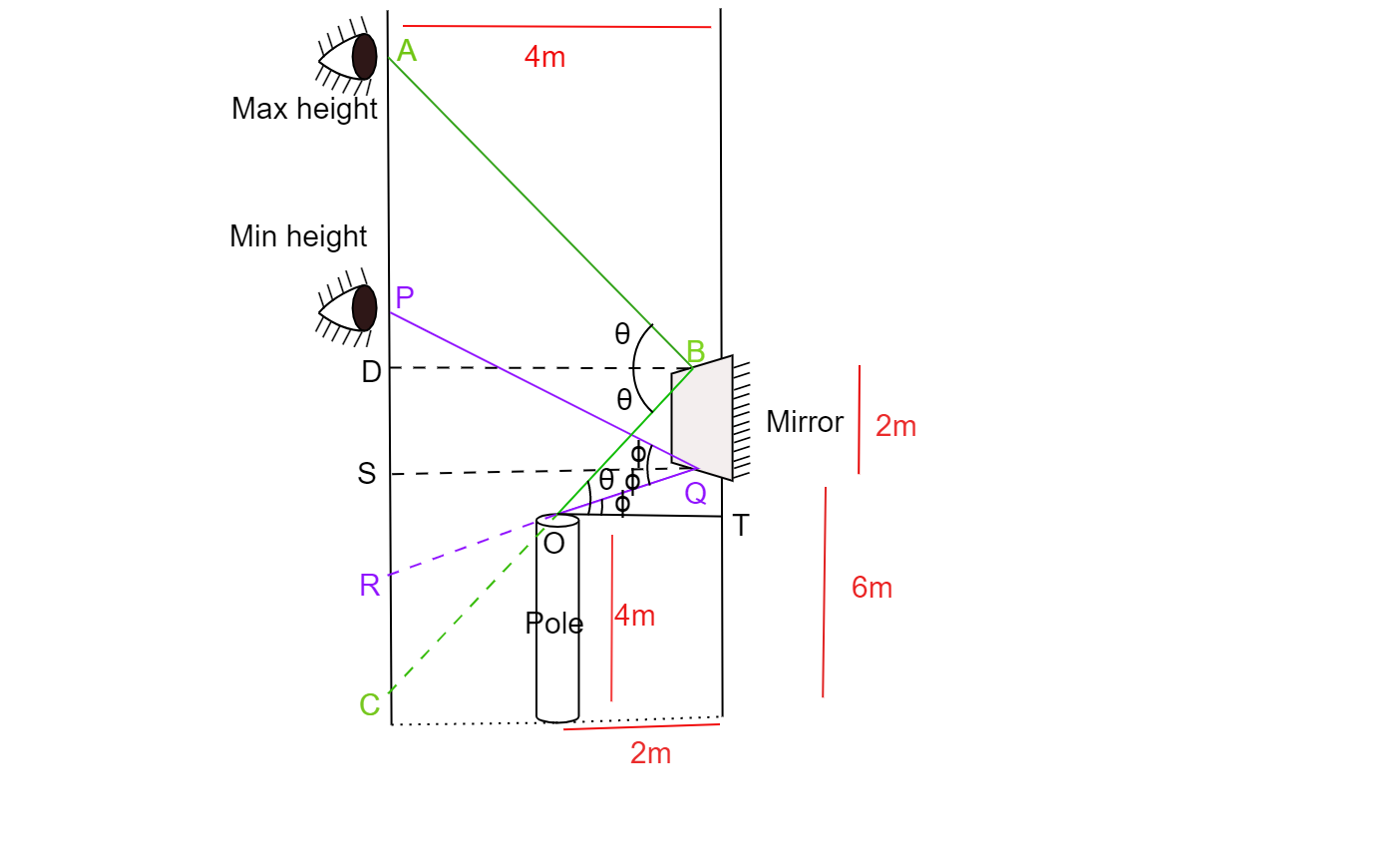Answer
405.3k+ views
Hint: A plane mirror reflects light in such a way that the angle of incidence is equal to the angle of reflection. Since the horizontal distance of the man, mirror and pole is fixed, the maximum and the minimum angle of incidence also have a definite value, which could be found by joining the top of the pole to the ends of the mirror.
Complete step by step answer:
Given that-
Height of pole$ = 4m$
Length of the mirror$ = 2m$
Height of the lower end of the mirror= 6m
Horizontal distance between the mirror and pole$ = 2m$
Horizontal distance of man from the mirror$ = 4m$
For minimum distance-
Let the minimum angle of incidence and reflection be$\phi $.
In triangles, PQS and QOT the angle$\phi $ is made, thus they are similar.
For triangle PQS,
$\tan \phi = \dfrac{{QT}}{{OT}}$
QT is the distance between the top of the pole and the lower end of the mirror. It is equal to $2m$.
OT is the horizontal distance between pole and the mirror it is equal to $2m$.
Therefore,
$\tan \phi = \dfrac{2}{2} = 1$
Angle of incidence,$\phi = 45^\circ $
We know that $\tan \phi = 1$
In triangle, PQS ,

$\tan \phi = \dfrac{{PS}}{{SQ}}$
Given, $SQ = 4$
Therefore, $PS = SQ\tan \phi $
$PS = 4 \times 1$
$PS = 4m$
The minimum vertical distance$6 + 4 = 10m$
For maximum distance-
Let the maximum angle of incidence and reflection be $\theta $
In triangle BOT,
The angle O is equal to $\theta $.
Thus, $\tan \theta = \dfrac{{BT}}{{OT}} = \dfrac{{BQ + QT}}{{OT}}$
$\tan \theta = \dfrac{{2 + 2}}{2} = \dfrac{4}{2} = 2$
$\tan \theta = 2$
Given, $DB = 4m$
In triangle ABD,
$\tan \theta = \dfrac{{AD}}{{DB}}$
Therefore, $AD = DB\tan \theta $
$AD = 4 \times 2 = 8m$
The maximum vertical distance $ = 6 + 2 + 8 = 16m$
The minimum distance where man can view the top of the pole is $10m$ and the maximum distance is $16m$.
Note:
A plane mirror produces a virtual, upright and same sized image of an object. The image appears to be situated at equal distance from the mirror surface. As the object distance is increased, plane mirrors can produce equally distant images, even vertically. The angle of incidence can vary from $0^\circ $to$90^\circ $.
Complete step by step answer:
Given that-
Height of pole$ = 4m$
Length of the mirror$ = 2m$
Height of the lower end of the mirror= 6m
Horizontal distance between the mirror and pole$ = 2m$
Horizontal distance of man from the mirror$ = 4m$
For minimum distance-
Let the minimum angle of incidence and reflection be$\phi $.
In triangles, PQS and QOT the angle$\phi $ is made, thus they are similar.
For triangle PQS,
$\tan \phi = \dfrac{{QT}}{{OT}}$
QT is the distance between the top of the pole and the lower end of the mirror. It is equal to $2m$.
OT is the horizontal distance between pole and the mirror it is equal to $2m$.
Therefore,
$\tan \phi = \dfrac{2}{2} = 1$
Angle of incidence,$\phi = 45^\circ $
We know that $\tan \phi = 1$
In triangle, PQS ,

$\tan \phi = \dfrac{{PS}}{{SQ}}$
Given, $SQ = 4$
Therefore, $PS = SQ\tan \phi $
$PS = 4 \times 1$
$PS = 4m$
The minimum vertical distance$6 + 4 = 10m$
For maximum distance-
Let the maximum angle of incidence and reflection be $\theta $
In triangle BOT,
The angle O is equal to $\theta $.
Thus, $\tan \theta = \dfrac{{BT}}{{OT}} = \dfrac{{BQ + QT}}{{OT}}$
$\tan \theta = \dfrac{{2 + 2}}{2} = \dfrac{4}{2} = 2$
$\tan \theta = 2$
Given, $DB = 4m$
In triangle ABD,
$\tan \theta = \dfrac{{AD}}{{DB}}$
Therefore, $AD = DB\tan \theta $
$AD = 4 \times 2 = 8m$
The maximum vertical distance $ = 6 + 2 + 8 = 16m$
The minimum distance where man can view the top of the pole is $10m$ and the maximum distance is $16m$.
Note:
A plane mirror produces a virtual, upright and same sized image of an object. The image appears to be situated at equal distance from the mirror surface. As the object distance is increased, plane mirrors can produce equally distant images, even vertically. The angle of incidence can vary from $0^\circ $to$90^\circ $.
Recently Updated Pages
How many sigma and pi bonds are present in HCequiv class 11 chemistry CBSE

Why Are Noble Gases NonReactive class 11 chemistry CBSE

Let X and Y be the sets of all positive divisors of class 11 maths CBSE

Let x and y be 2 real numbers which satisfy the equations class 11 maths CBSE

Let x 4log 2sqrt 9k 1 + 7 and y dfrac132log 2sqrt5 class 11 maths CBSE

Let x22ax+b20 and x22bx+a20 be two equations Then the class 11 maths CBSE

Trending doubts
Fill the blanks with the suitable prepositions 1 The class 9 english CBSE

At which age domestication of animals started A Neolithic class 11 social science CBSE

Which are the Top 10 Largest Countries of the World?

Give 10 examples for herbs , shrubs , climbers , creepers

Difference between Prokaryotic cell and Eukaryotic class 11 biology CBSE

Difference Between Plant Cell and Animal Cell

Write a letter to the principal requesting him to grant class 10 english CBSE

Change the following sentences into negative and interrogative class 10 english CBSE

Fill in the blanks A 1 lakh ten thousand B 1 million class 9 maths CBSE



